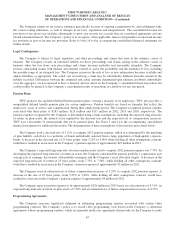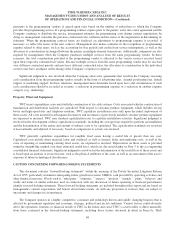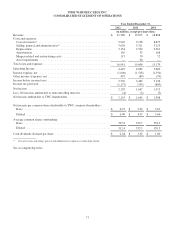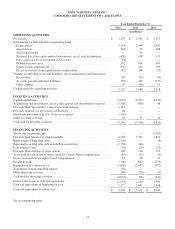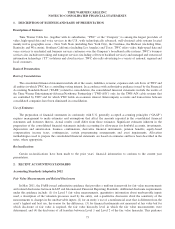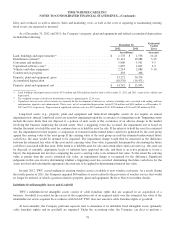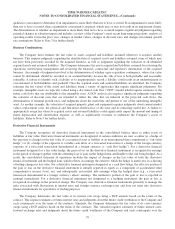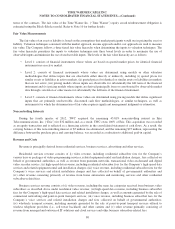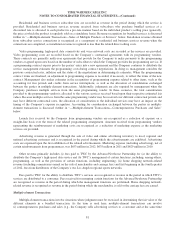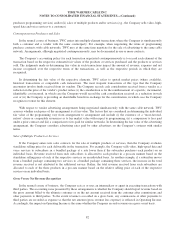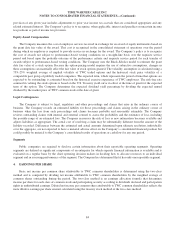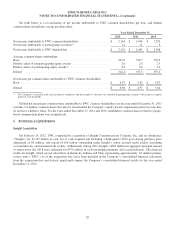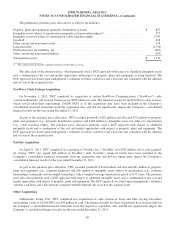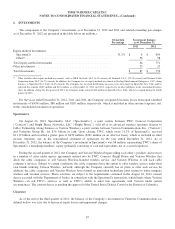Time Warner Cable 2012 Annual Report Download - page 87
Download and view the complete annual report
Please find page 87 of the 2012 Time Warner Cable annual report below. You can navigate through the pages in the report by either clicking on the pages listed below, or by using the keyword search tool below to find specific information within the annual report.
TIME WARNER CABLE INC.
NOTES TO CONSOLIDATED FINANCIAL STATEMENTS—(Continued)
Accounts Receivable
Accounts receivable are recorded at net realizable value. The Company maintains an allowance for doubtful accounts,
which is determined after considering past collection experience, aging of accounts receivable, general economic factors and
other considerations. Changes in the Company’s allowance for doubtful accounts from January 1 through December 31 are
presented below (in millions):
2012 2011 2010
Balance at beginning of year ..........................................$ 62 $ 74 $ 74
Provision for bad debts(a) ............................................. 224 221 237
Write-offs, net of recoveries ........................................... (221) (233) (237)
Balance at end of year ................................................$ 65 $ 62 $ 74
(a) Provision for bad debts primarily includes amounts charged to expense associated with the Company’s allowance for doubtful accounts and excludes
collection expenses and the benefit from late fees billed to subscribers.
Investments
Investments in companies in which TWC has significant influence, but less than a controlling interest, are accounted for
using the equity method of accounting. Under the equity method of accounting, only TWC’s investment in and amounts due
to and from the equity investee are included in the consolidated balance sheet; only TWC’s share of the investee’s earnings
(losses) is included in the consolidated statement of operations; and only the dividends, cash distributions, loans or other cash
received from the investee, additional cash investments, loan repayments or other cash paid to the investee are included in the
consolidated statement of cash flows. TWC’s investments are primarily accounted for using the equity method of accounting.
Additionally, the carrying value of investments accounted for using the equity method of accounting is adjusted downward
to reflect any other-than-temporary declines in value. A subjective aspect of accounting for investments involves determining
whether an other-than-temporary decline in value of the investment has been sustained. If it has been determined that an
investment has sustained an other-than-temporary decline in its value, the investment is written down to its fair value by a
charge to earnings. This evaluation is dependent on the specific facts and circumstances. TWC evaluates available information
(e.g., budgets, business plans, financial statements, etc.) in addition to quoted market prices, if any, in determining whether an
other-than-temporary decline in value exists. Factors indicative of an other-than-temporary decline include recurring operating
losses, credit defaults and subsequent rounds of financing at an amount below the cost basis of the Company’s investment. This
list is not all-inclusive and the Company weighs all known quantitative and qualitative factors in determining if an other-than-
temporary decline in the value of an investment has occurred. Refer to Note 6 for further details.
Long-lived Assets
TWC’s long-lived assets consist primarily of property, plant and equipment and finite-lived intangible assets (e.g., cable
franchise renewals and access rights). Property, plant and equipment are stated at cost and depreciation on these assets is
provided using the straight-line method over their estimated useful lives. Acquired customer relationships are capitalized and
amortized over their estimated useful lives and costs to negotiate and renew cable franchise rights are capitalized and
amortized over the term of the new franchise agreement.
TWC incurs expenditures associated with the construction of its cable systems. Costs associated with the construction of
transmission and distribution facilities are capitalized. With respect to customer premise equipment, which includes set-top
boxes and high-speed data and telephone modems, TWC capitalizes installation costs only upon the initial deployment of
these assets. All costs incurred in subsequent disconnects and reconnects of previously installed customer premise equipment
are expensed as incurred. TWC uses standard capitalization rates to capitalize installation activities. Significant judgment is
involved in the development of these capitalization standards, including the average time required to perform an installation
and the determination of the nature and amount of indirect costs to be capitalized. The capitalization standards are reviewed
at least annually and adjusted, if necessary, based on comparisons to actual costs incurred. TWC generally capitalizes
expenditures for tangible fixed assets having a useful life of greater than one year. Capitalized costs include direct material,
77


